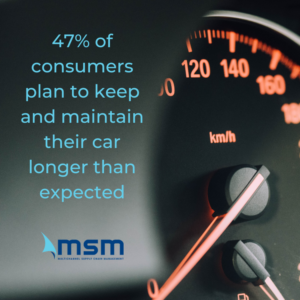The COVID-19 Pandemic along with the Recession has impacted the economy. The auto industry has been particularly hit hard. In a previous post, we talked about how the economy is affecting car buyers, and in this part two article, we will talk about a few of the ways that it has affected how auto dealerships operate.
How the Economy is Affecting Auto Dealerships
The Coronavirus Pandemic was the first hit to the auto industry. Most data shows car sales dropped around 10% in 2019, and another 15% in 2020, with car production dropping around 11% in 2019 and 16% in 2020. While 2021 saw an improvement, it was still significantly below pre-pandemic sales and production. Then, the economy of 2022 and the recession hit. Auto dealerships could not fully recover from the pandemic before another economic impact hit.
Let’s look at four reasons car dealerships are struggling in this economy, and then uncover why some car dealerships are experiencing record profits despite the downward economic turn.
Decrease in Car Sales
This is fairly obvious that a decrease in car sales during the pandemic was inevitable, and that in a down economy, auto sales would drop. But, it’s essential to look at why sales dropped to understand how some car dealerships thrive despite the slowdown.
There are three main reasons that car sales dropped.
Lockdowns and Health Concerns
When COVID-19 hit, people were forced to stay home. They could not go to car dealerships if they had to stay home. Despite the rise of online car buying options, the data shows that most car buyers still like to purchase at car dealerships (though most shop online first).
Then, the ongoing health concerns and fears of contracting COVID-19 had consumers limiting in-person shopping far beyond when the lockdowns lifted. Though auto dealerships were classified as an “Essential Business,” few people shopped at any retail locations early in the pandemic. Even in states like Florida, with limited lockdowns and with the lowest average car price in the nation, car sales remained lower than in pre-pandemic times. While some buyers still found their way to dealerships, and some purchased cars online, many decided to delay their car purchase.
Fewer Car Buyers in the Market
 While the shutdowns related to Covid temporarily limited the number of car buyers in the market, there has been a continued reduction in the number of auto buyers in the market. While the ever-increasing popularity of ride-sharing apps plays a role in this decline, the bigger culprit in the decrease in buyers is the work-from-home trend.
While the shutdowns related to Covid temporarily limited the number of car buyers in the market, there has been a continued reduction in the number of auto buyers in the market. While the ever-increasing popularity of ride-sharing apps plays a role in this decline, the bigger culprit in the decrease in buyers is the work-from-home trend.
During Covid, many companies implemented temporary work-from-home policies. Then, over half of those companies allowed at least some remote work. One of the biggest reasons to own a car is for transportation to and from work, and fewer people are now driving to work. And, those working in an office are commuting to the office less frequently, reducing their daily miles driven, extending the life of their car, and decreasing the frequency in which they’ll purchase a new vehicle. 47% of consumers plan to keep and maintain their car longer than expected when originally purchasing their vehicle.
Higher Car Prices
Everything is costing more these days, and vehicles are no exception. In fact, the price of cars, perhaps only behind the price of gas, is one of the first things consumers notice. The average price of a car was under $40,000 less than five years ago, but the average cost of a new car is now over $47,000. Part of the increase in pricing is because dealers face a higher purchase price on their end. However, part of the increase is because everything is costing dealers more, from cars to employees, to uniforms and printer ink. As a result, dealerships have to charge more for cars to offset those costs.
Many consumers have been turning to used car sales, with new car prices at an all-time high. Despite used car prices increasing as much as 46%, many buyers could not afford the higher-priced new cars. Other buyers have been pushing off the purchase of their cars, with the hope that car prices will decrease. While there is good news for the auto industry, with used car sales nearing pre-pandemic levels, it does not look like new car sales will return to pre-pandemic levels within the following year.
How Auto Dealerships Increased Profit During the Pandemic and Recession
While the pandemic and subsequent recession put some car dealerships out of business, several being forced to sell to larger, more financially secure dealerships, and others struggling to stay afloat, some auto dealerships were seeing record profits. Here are a few ways those dealerships are experiencing record profits:
3 Ways Car Dealerships Increased Profit
There are several ways that auto dealerships are increasing profits. While this is not an exhaustive list, these are the three main things being done by auto dealerships that have led to increased profits through the pandemic and into and through the recession.
Online Marketing and Sales
While 61.4% of consumers prefer to purchase their vehicle at the dealership, an increasing amount do purchase online, and over 80% of in-person car buyers shop online before purchasing. In addition, consumers spend 59% of their total buying time online. As a result, dealerships with a solid online presence and digital shopping processes are winning the day.
A strong online presence for an auto dealership does not just mean having the ability to sell online. While being set up for consumers to purchase a car from you entirely online, having a user-friendly, well-optimized website to reach the right buyers, and accompanied by quality social media and online ads, allows some auto dealerships to excel in the modern digital shopping and buying economy.
Reducing Internal Costs
An often overlooked fundamental of good business practice is decreasing costs, especially during challenging economic times. Currently, both car prices and employee/staffing prices are up. There is not much you can do about those costs; those are the cards all dealers have been dealt, but, dealerships can reduce costs in several other areas. The dealerships that are experiencing record profits have found ways to significantly reduce their expenses.
Vendor lists for most car dealerships are several pages long. Products are purchased from, and services are provided by many companies. Often, these can be reduced, thus streamlining and cutting expenses. And, car dealerships are notorious for just purchasing the way, and from the person, they always have. Dealerships experiencing record profits have looked into reducing costs on everything, including things like uniforms, cleaning supplies, printer toner and print management. The quickest way to a larger profit is to reduce your current costs.
Offering More
Vehicle dealerships that are experiencing record profits have found ways to offer more to their customers, while not driving up their internal costs. When we think about CarMax and its popularity, part of that is not just because a buyer can sit in their pajamas at home throughout the buying process, but also because most of what they might need along with the new car is also provided digitally at the time of purchase. This is important for car dealers for in-dealership sales, too.
While not all offerings of additional products and services drive revenue, anything of value that can be offered to a buyer can be part of a unique buyer proposition as a marketing tool to drive buyers to their website and into their dealerships. And, at the time of purchase, there are several different products. that dealerships can sell or facilitate third-party service and product sales.
There are some great signs for car dealerships, which is good news most industries aren’t experiencing right now. But, with the economy still struggling, the road to success won’t be easy for car dealerships through the rest of 2022 and likely through 2023. However, many auto dealerships are experiencing record profits, and others can make the changes necessary to excel in this economy by taking into account much of what we discuss in this article.







